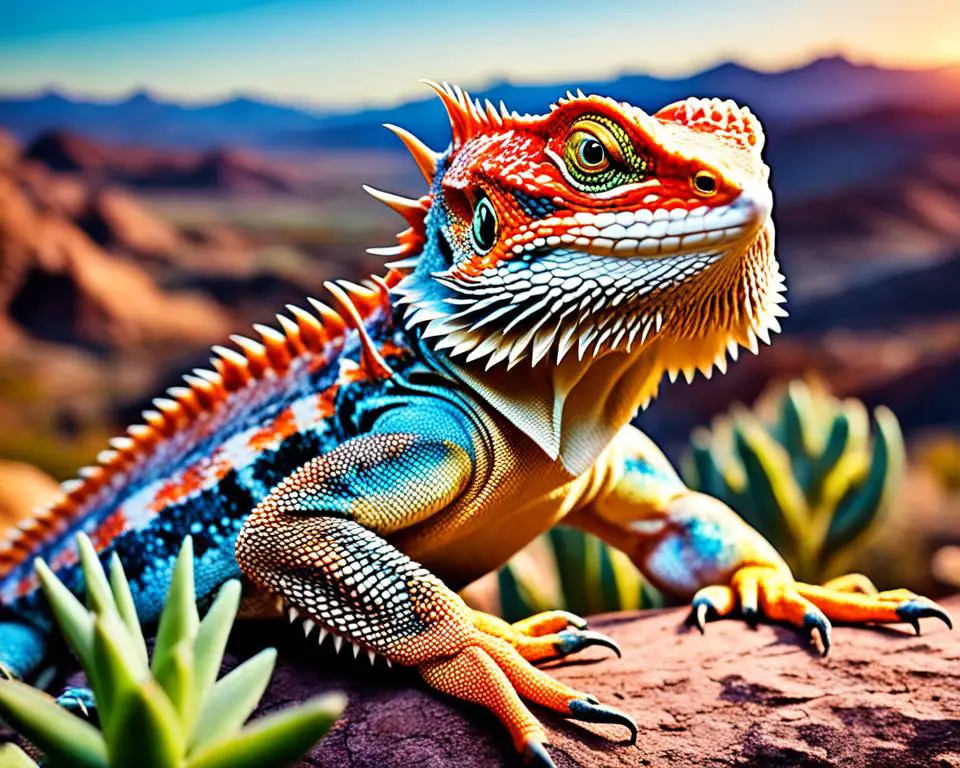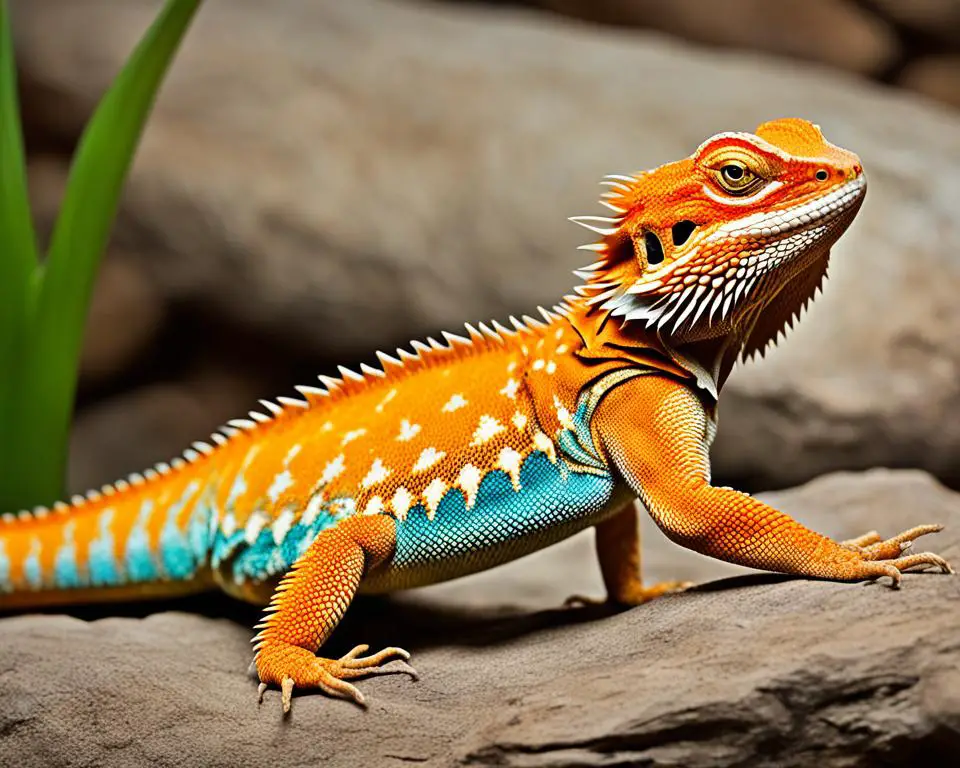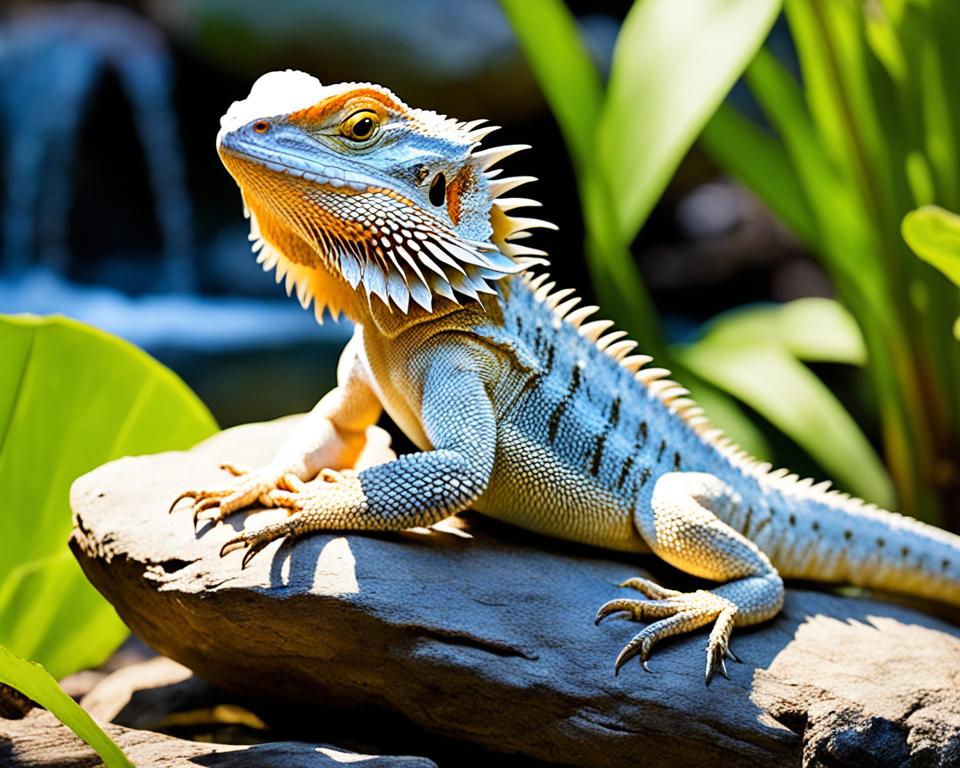Baby bearded dragons require quality nutrition to thrive, making food selection especially important during their first few years.
Crickets offer excellent nutrition for young dragons. As a general guideline, baby bearded dragons should consume 40-60 crickets daily.
Larger insects like mealworms can also be provided as they grow, alongside fruits and vegetables.
Proper research into every aspect of feeding is crucial before acquiring baby bearded dragons. This article will outline best practices for breeding, preparing, and feeding crickets to babies.
Let’s begin!
How often should your bearded dragon eat crickets?
Generally, baby dragon crickets should be fed three times a day. This will help ensure that your bearded dragon gets all the necessary vitamins and minerals it needs to grow healthy and strong.
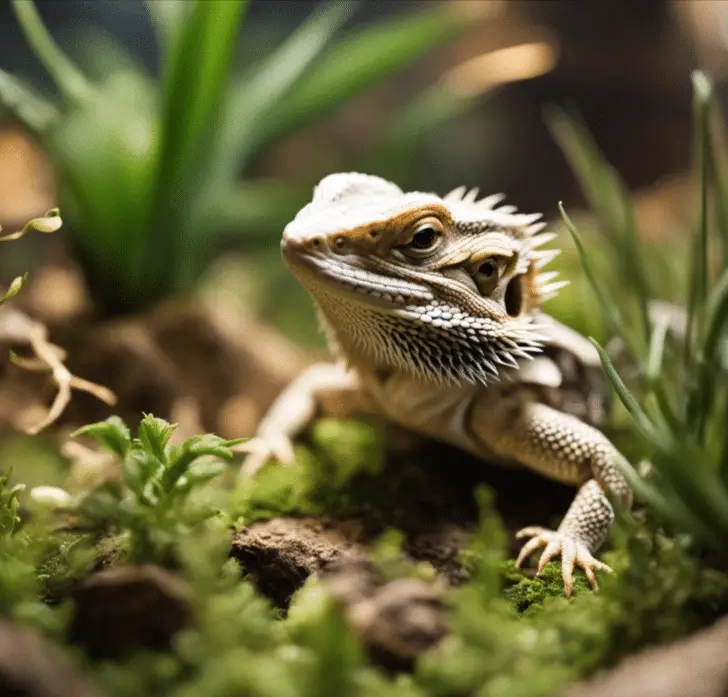
That said, to help you remember how often you need to feed your bearded dragon, take into consideration the following feeding frequency:
- Babies (<6 months): Feed 40-60, 10-20 crickets per feeding throughout the day.
- Juvenile (6-12 months): Feed 20-40, 8-12 crickets per feeding throughout the day.
- Adults (>12 months): Feed 10 daily, 5 crickets per feeding.
Consider individual variation in body condition and activity levels when determining feeding amounts.
Provide a variety of feeder insects in addition to crickets. Dust crickets with calcium and vitamins 1-2x weekly.
Frequent, nutritious meals are important for juveniles’ growth, but adults only require maintenance levels once they are fully grown.
Juvenile beardies
When it comes to feeding juvenile dragons, you first need to know that they require a high-protein diet. This means that your little one will need at least two or three hearty meals of crickets per day in order to grow.
Crickets are an excellent source of protein, particularly for rapidly growing animals like baby dragons. But why crickets?
Well, besides providing ample nutrients and essential amino acids, crickets are also quite easy to digest and can be readily metabolized by your dragon’s rapidly developing body.
So, if you are worried about providing the right food for your cute little dragon, rest assured that insects like crickets can help ensure their rapid growth.
Baby dragons
If you’re looking to breed baby dragons, you’ll want to ensure that you feed them a balanced diet.
For example, you can use cricket nymphs (the immature form of crickets) instead of adult crickets. Nymphs are smaller than adults, but they are a fantastic protein source containing many vital nutrients.
Nymphs are perfect for raising baby dragons because they are easier to handle and less likely to bite. Plus, they are much cheaper than buying adult crickets.
Nymphs are best used between one month and six months of age. They are ideal for small baby dragons who weigh no more than 6.63 ounces (188 grams).
Can a bearded dragon eat dead crickets?
It’s common for bearded dragon owners to occasionally need to feed their pets dead crickets rather than live ones.

Dead crickets can still be a nutritious food source for bearded dragons. While some dragons may show more enthusiasm for chasing and catching live crickets, most will still readily consume dead crickets that are offered to them.
Are frozen crickets suitable for bearded dragons?
Yes, frozen crickets can be a suitable food option for bearded dragons. Here are some key points about feeding frozen crickets:
Frozen crickets retain much of their nutritional value even after being frozen. They provide protein, calcium, vitamins, and minerals to support bearded dragons’ health and growth.
It’s best to gut-load live crickets for several days prior to freezing them to boost their vitamin and mineral content. This ensures frozen crickets offer optimal nutrition.
Bearded dragons can lose interest in pre-killed or frozen prey over live wiggly insects. Owners may need to introduce frozen crickets slowly at first. Placing them in warm water briefly before feeding can increase appeal.
A diet of exclusively frozen crickets is not recommended long-term, as the hunting/chasing of live prey is important mental and physical stimulation.
But frozen crickets are a suitable occasional or backup food.
Proper storage is important – crickets should be frozen quickly after killing and kept in an airtight container in the freezer to maintain quality for several months.
Providing a variety of appropriately sized live and frozen insects helps ensure bearded dragons receive balanced diets and don’t lose interest over time.
So, in moderation as part of a varied diet, frozen gut-loaded crickets can be an easy-to-use and nutritious food for bearded dragons. It’s a convenient option when live crickets are not readily available.
What is the appropriate size of crickets to feed a bearded dragon?
When feeding crickets to bearded dragons, the appropriate size depends on the size of the dragon. Here are some guidelines:
- For baby bearded dragons under 6 months old, the ideal cricket size is about the distance between the dragon’s eyes or slightly smaller. This ensures they can eat enough without the crickets being too large.
- For juvenile bearded dragons 6-12 months old, cricket size should be approximately the width of the space between the dragon’s eyes.
- For sub-adult bearded dragons 1-2 years old, cricket size can increase to about 1.5 times the space between the eyes.
- For adult bearded dragons over 2 years old, full-sized adult crickets are generally appropriate as the main staple insect.
It’s important not to feed crickets or any prey item larger than the distance between the dragon’s eyes.
Smaller sizes are always safer, especially for babies and juveniles. Proper cricket size ensures bearded dragons can capture, handle, and swallow their food without risk of choking.
Breeding your own crickets
If you’d rather raise your own crickets, there are several ways to do it. The most common method involves using a homemade cage.
It’s actually quite easy to do, and you’ll save some money in the long run. Plus, breeding your own crickets ensures that they are always fresh and nutritious.
Here’s a quick overview of how to breed your own crickets:
- Start with a small container, such as a shoe box.
- Line the bottom of the container with about 1 to 2 inches (2.5 to 5 cm) of moistened potting soil.
- Add a few crickets to the container.
- Place the container in a warm, dark place like a closet.
- Check on the crickets every few days and add more food and water as needed.
- After about 2 to 3 weeks, you should have a healthy population of crickets.
You can check the current price of cricket food on Amazon by clicking here.
How do I feed bearded dragons?
Crickets should always be fed to your bearded dragon. This means that you’ll need to purchase them from a reputable source, such as a pet store or online retailer.
You can also breed your own crickets, as we mentioned earlier.
Once you have your live crickets, there are a few things you’ll need to do before feeding them to your dragon.
Before feeding your bearded dragon crickets, you should sprinkle them with a calcium powder supplement to ensure that your bearded dragon is getting the nutrients it needs.
You can purchase a calcium powder supplement at your local pet store or on Amazon by clicking here.
To dust the crickets, simply place them in a bag or container with the calcium powder and shake them around until they are coated. Once they are dusted, you can place the crickets in your dragon’s enclosure.
How big of a cricket can a bearded dragon eat?
The cricket size should not be larger than the distance between the dragon’s eyes. A good rule of thumb is to ensure that the cricket’s correct size does not exceed 1/2“ to 5/8“ long.
When it comes to feeding your pet beardie, one of the most important factors to consider is the size of the cricket. In fact, the cricket should be no bigger than the space between your dragon’s eyes.
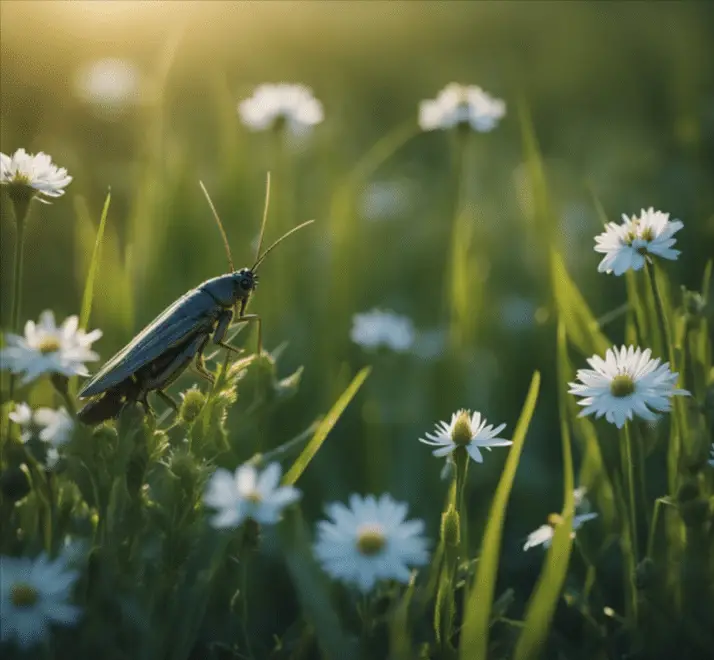
This will help prevent choking and other digestion issues. That said, you’ll want to ensure that the cricket is not too large in proportion to your dragon’s body.
Ideally, it should be roughly equal or a little smaller. A good rule of thumb is to look for crickets that are 5/8“ long or less.
To determine whether cricket is appropriate for your pet lizard, simply hold it up alongside your dragon’s head and compare its length with its own. Now, there are many other different types of bugs that bearded dragons can eat apart from crickets.
In fact, as they grow older, you’ll want to start incorporating a variety of different insects into their diet. However, we recommend sticking with crickets for the first few months as they are the easiest to digest.
How age affects the number of crickets bearded dragons eat
As your bearded dragon grows older, he may begin to lose interest in eating his meal. This is perfectly normal behavior. As your bearded dragon ages, it will need to eat less frequently than when it was younger.
For example, baby beardies might need to eat 10-20 crickets per day, while an adult bearded dragon might only need to eat 5-10 crickets in a day. That’s half the number of crickets a young dragon eats!
You’ll also want to start incorporating a variety of different insects into its diet. This will help ensure that your bearded dragon gets the nutrients it needs as it ages.
Why crickets?
Crickets are actually quite easy to feed. They’re relatively inexpensive and require very little maintenance, which makes them perfect for feeding baby dragons.
Plus, crickets are also a great source of protein for your bearded dragon. In fact, they provide your beardie with essential vitamins and minerals such as fat, calcium, potassium, zinc, magnesium, copper, folate, biotin, pantothenic acid, and iron.
Always crickets?
While crickets are a great option for bearded dragons, there are plenty of other options out there. For instance, you could give them fresh green leaves, fruit flies, and vegetables (in moderation) like carrots, broccoli, or peas.
If you’d prefer to stick with crickets, then make sure that you buy them from reputable suppliers. You don’t want to end up buying crickets that have been treated with pesticides or insecticides.
The same goes for any food items you plan to feed your bearded dragon. Always check the ingredients list before purchasing anything. If you see any chemicals listed, then steer clear of those products.
The importance of feeding live crickets to bearded dragons
One of the most important things for any bearded dragon owner to understand is the importance of feeding healthy and nutritious crickets to their pets.
Live crickets provide bearded dragons with essential nutrients and play an important role in helping your reptilian friend maintain a healthy digestive tract.
When you purchase live crickets from reputable suppliers, you will be able to tell if they are healthy by taking a quick look at their appearance. Healthy crickets will look lively and vibrant, while those that are sickly or dying will look pale and lethargic.
Therefore, always choose live crickets over dead ones. Dead crickets won’t provide your bearded dragon with any nutrition whatsoever.
Can you leave crickets in a bearded dragon cage overnight?
No, you should not leave crickets in a bearded dragon cage overnight. Crickets are known to bite and can cause harm to your dragon.
Therefore, once your baby beardies have finished eating, you should remove any uneaten crickets from their cage.
Summary
After reading this article, don’t you think it would be great if we could talk about what you just read and better retain the information?
Take a look at the following key points to help you take action on what you have learned in this article:
- Live crickets provide bearded dragons with essential nutrients and help them maintain a healthy diet. Always choose live crickets over dead ones.
- Do not leave crickets in a bearded dragon cage overnight, as they can bite your beardie.
- Feeding crickets to bearded dragons helps to promote their natural behaviors, such as hunting and foraging, which enhance mental stimulation.
- Bearded dragons require a variety of foods to thrive. They do not like eating only one type of food.
- If you are unsure whether your bearded dragon requires additional nutrition, consult your veterinarian.
Final thoughts
As you can see, a variety of factors need to be considered when determining how many crickets to feed your bearded dragon.
In this article, we’ve provided you with some general guidelines. However, it’s important to remember that every dragon is different, so pay attention to your pet’s needs.
With a little practice, you’ll be sure to find the perfect feeding schedule for your beloved beardie in no time!
Want to learn more about bearded dragons?
Ready to boost your knowledge about your favorite reptile? If so, check out our other articles below:
- What Bugs Can a Bearded Dragon Eat? ( 7 Must-Have Bugs)
- How Many Crickets Should a Bearded Baby Dragon Eat? (Explained)
- Why Do Bearded Dragons Poop in Their Water Bowls? Read This First!



